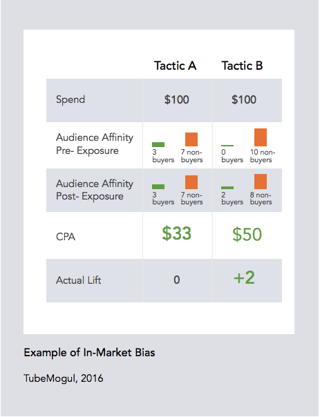Attribution Buyers Guide: Measuring at the Person Level – Part One

During the course of this series we’ve been looking at current tools available to marketing professionals to help improve performance and boost ROI. In preparing this series we found, pretty consistently, those responsible for delivering effective communications and advertising programs are frustrated with current options. One thing, however, stood out to us. Over the past few years, with the explosion of consumer options for both entertainment and information, a new challenge has presented itself to marketing professionals. Gartner analyst Christi Eubanks presented the problem most succinctly, “We still don’t have a consistent view of the customer” and we need one to “optimize spend, increase attention, and maximize satisfaction”.
This failure of existing tools to “see the consumer” can cause huge problems when looking at the performance of one’s marketing mix. Here’s an example. Let’s say an email marketing manager is primarily focused on generating sales through your website. Tying email performance to e-commerce seems on the surface to be a logical connection. However, in the case where one is selling both online and offline, this approach fails to appreciate the impact email may be having on brick-and-mortar sales. Without a consistent view of the customer, you may miss the insight that extra emails are hurting open rates, and, therefore, hurting sales in retail locations. Overall, for every additional $1.00 one might be making in online sales there may be a loss of $3.00 in overall sales.
Most marketers understand and are looking for tolls that help them better understand their customers’ needs and intentions. This gives them the opportunity to create more ideal customer journeys, improving sales and brand satisfaction.
In our next two installments of our Attribution Buyers Guide series we will try to identify some of the key challenges marketers face in seeing their customers more clearly and identifying better consumer journeys.
Aggregated vs People-Based
While MTAs introduced the ability to measure digital exposure and digital sales or KPI data at a person-level, most models including Media Mix Modeling (MMM) aren’t performed at a person-level, resulting in fuzzy low fidelity conclusions that miss the “why” of what works. Looking at traditional media spend and sales in bulk, therefore, impairs useful decisions beyond basic allocations to top-level marketing channels. Marketers who want to understand what’s working and to optimize in more detail should look for platforms that incorporate as much individual-level data as possible, including: sales data, exposure data across media types, weather and other location-based data, and other person-level attributes.
Why This Matters
The inability to measure at a person-level assumes that everyone behaves identically as implied by the average performance result, rendering marketing attribution a blunt tool. Person-level measurement is the key to understanding differences between audiences and even different profiles within audience groups. Marketers who can measure at a person-level enable detailed optimizations that can easily increase ad effectiveness by 20% or more.
What to Ask
- Please describe any methods for measuring person-level activity outside of digital channels (e.g. TV, print, billboards, radio); please describe how you connect, unify and deduplicate the data with digital user data.
- What person-level data sources does your company use to supplement cookie or ID-level data (demographic, financial, behavioral, etc.)?
Flawed Methodologies
MTAs have developed complex algorithms that attempt to assign fractional weightings to different touchpoints in the user’s purchase path. These algorithms are non-transparent, in many cases, and are considered “black boxes” making it difficult to analyze how they work. What’s most problematic is that marketers who have tested the effectiveness of these models have found them to be subject to several “biases” which may significantly impair their conclusions. These biases stem from reliance on correlation-based analysis when analyzing path-to-purchase. The bias results in erroneous conclusions that one activity caused a result, when in reality the result may have happened anyway. These biases include:

In-Market Bias: Where people are already likely to buy your product appear to be the best performing targets, when the advertising may not have added any value to the sale.
Cheap Inventory Bias: Also known as “cookie bombing,” whereby lower cost media will look like a stronger performer than higher cost media because of a natural rate of conversion within the targeted population, when the advertising may not have added as much value to the sale.
Both of these biases may lead marketers to conclude that tactics adding less value, or lift, outperformed tactics that add more value, or lift, resulting in exactly the wrong optimization decisions. Instead, marketers should seek solutions that employ experimental design-based methodologies. The gold standard according to the Advertising Research Foundation (ARF) is to use a “placebo”-based control group, whereby all conditions between two otherwise identical groups within a target audience are the same, with the exception that one is exposed to advertisements, and the other is not. This enables isolated measurement of the effect of the advertising. Variations of the “placebo” approach include establishing a “hold-out” group for testing, which has potential imperfections but offers a benefit of lowering testing costs.
Why This Matters
These biases can lead to optimizations toward the least effective strategies and tactics which can have a disastrous effect on ROI. Attribution is supposed to help you grow the half that’s working, not the half that’s not working!
Further, if the goal is to create a cultural change that elevates the value of marketing and analytics, then the “gold-standard” validation may be critical to success. Having built-in validation and control methodologies can help shift marketing to be seen as a predictable revenue driver rather than as a cost center.
“Correlation does not equal causation. What many attribution models lack is a way to identify consumers that were already going to purchase. This identification is crucial because targeting certain audiences, including brand loyalists or people who have already visited a web page, naturally correlates with low CPAs…. There is also a low-rate bias. The easiest way to get a low CPA is to deliver media as efficiently as possible. Conventional logic argues that one can increase actions by increasing opportunities. This, however, may lead to “cookie bombing,” or deliberately delivering media as cheaply as possible without regard for media quality, in terms of viewability or publisher reputation, to audiences that are already on the path to conversion.”
– Tom Riordan, Director of Special Operations, TubeMogul
What to Ask
- Does your platform analyze the path to purchase?
- Does your platform incorporate experimental design, or, a control group?
- How does your platform ensure that we are measuring lift rather than taking credit for events that may happen anyway?
Missing Message Signal
Creative-level testing offers marketers significant upside and differentiation, as it is often ignored or misguided. Your creative is the advertising – the media is simply the container in which it’s delivered. With MMM, creatives are evaluated in the aggregate, if at all, without regard for which message worked with which target groups, often leading to a winner-takes-all conclusion. In fact, certain creatives may be effective for some audiences and in certain formats, while other creatives will be more effective for other audiences and formats. This is the beauty of targetability, but the most common measurement tools for brand advertisers - MMMs - don’t allow targetability to come anywhere near its potential! MTAs similarly lack a native ability to understand audience-level message effectiveness, disregarding a critical performance signal. Marketers should ensure that their platforms are able to identify which people are being influenced by which message, while the campaign is running, both for online and offline media, whether they have a single message, or a portfolio of messages.
Why This Matters
A campaign’s success is driven by messaging and creative. Overlooking the interdependences between creative, media channels and person-level audiences significantly dilutes the potential effectiveness of attribution measurement, and when combined with other flaws identified in this guide, the faulty outcome is to migrate to a winner-takes-all lower-funnel creative.
What to Ask
- How granularly does your solution measure creative effectiveness – in the aggregate, audience segment-level, or person-level?
- Can your company’s solution identify creatives, depending on where an audience is in its buying process (e.g. which work for message association for someone who’s just beginning to research our category, which work for intent for someone who is close to purchasing)?
On one level, marketers understand intuitively that a consistent view of customers is mission-critical. It is hard, though, to get this view and many find themselves falling into the trap that older attribution models, that weren’t designed with the consumer journey in mind, have created. Stay tuned for our next article in this series that will explore additional challenges to obtaining a clear, consistent view of customers and present ways to overcome them to drive online and offline media optimization.

